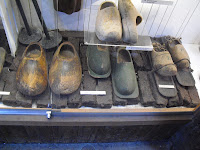Cultural Blog
5th - 12th March
 There are many things which we associate with being typically Dutch yet after speaking to some Dutch students they informed me that many of these objects did not originate in The Netherlands. For instance it surprised me to find out that tulips originated in Turkey. Clogs or ‘klompen’ on the other hand are assuredly Dutch and they take great pride in these.
There are many things which we associate with being typically Dutch yet after speaking to some Dutch students they informed me that many of these objects did not originate in The Netherlands. For instance it surprised me to find out that tulips originated in Turkey. Clogs or ‘klompen’ on the other hand are assuredly Dutch and they take great pride in these.  The Dutch have been wearing clogs since medieval times. Originally, they were made with a wooden sole and a leather top or strap tacked to the wood. Eventually, the shoes were made entirely from wood to protect the whole foot. Wooden shoe wearers claim the shoes are warm in winter, cool in summer and provide support for good posture. The wood also absorbs perspiration so that the foot can breathe. In my estimation this sounds like the ideal shoe for healthy feet and one any podiatrist would recommend. Contrary to this in an extract by Wilson (1937), he argued that the only reason the Dutch wore clogs was because they lasted longer than shoes of a comparable price thus reflecting the notion of the Dutch being tight with money!
The Dutch have been wearing clogs since medieval times. Originally, they were made with a wooden sole and a leather top or strap tacked to the wood. Eventually, the shoes were made entirely from wood to protect the whole foot. Wooden shoe wearers claim the shoes are warm in winter, cool in summer and provide support for good posture. The wood also absorbs perspiration so that the foot can breathe. In my estimation this sounds like the ideal shoe for healthy feet and one any podiatrist would recommend. Contrary to this in an extract by Wilson (1937), he argued that the only reason the Dutch wore clogs was because they lasted longer than shoes of a comparable price thus reflecting the notion of the Dutch being tight with money! 
On our trip to Zaanse Schans we had the opportunity to visit a tradesman’s workshop and see the clogs being crafted. The shoes are made by machine today but there are still a few wooden shoe makers in Holland who are able to hand craft these shoes. Given the shape of the shoe and it being one single piece of wood with no joints it was very interesting to see them gradually take shape after beginning with a one rectangular piece of wood. Afterwards many of us had fun finding clogs our size and trying them on to experience them for ourselves. Personally I still cannot understand how they can be comfortable for everyday use as they are worn a size bigger than your normal shoe size resulting in your feet sliding about inside them as you walk.
 As well as this there was an exhibition of the many clogs that have been made down through the years, all with different purposes and therefore varying in shape, design and colour. This was very interesting as we were able to see how the clog evolved and changed over time.
As well as this there was an exhibition of the many clogs that have been made down through the years, all with different purposes and therefore varying in shape, design and colour. This was very interesting as we were able to see how the clog evolved and changed over time.  In speaking with a Dutch student he said that if you walked down a street with clogs on in the present day people would give you a funny look. In any case this is probably true as I have not yet seen anybody wearing clogs other than the tradesman at the clog workshop. He told me that only farmers, fishermen and factory workers still wear clogs. As well as being waterproof, clogs also protect the foot from heavy and sharp objects therefore being very practical for these people.
In speaking with a Dutch student he said that if you walked down a street with clogs on in the present day people would give you a funny look. In any case this is probably true as I have not yet seen anybody wearing clogs other than the tradesman at the clog workshop. He told me that only farmers, fishermen and factory workers still wear clogs. As well as being waterproof, clogs also protect the foot from heavy and sharp objects therefore being very practical for these people.After hearing the origin of the clog and finding out more about its practicality and benefits I found myself wondering why the majority of society have stopped wearing clogs as part of their everyday life. The only possible conclusion I could come to was that of the modernising of society and the trends in fashion that are present all over the world. Down through the generations maybe these people have abandoned the uniqueness of the clog to conform to society’s notion of fashionable. This is also likely to be the case for our own society back home, down through the years I’m sure unique objects, events and ways of life have been abandoned by generations in place of more modern ideas.
Kathryn
No comments:
Post a Comment